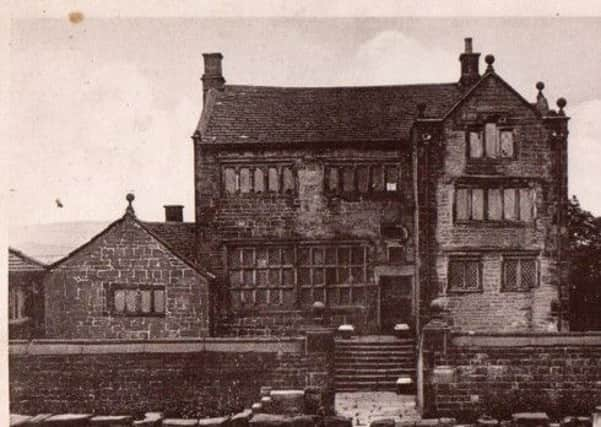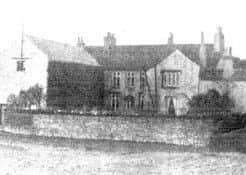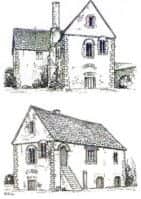Archaeologists to uncover secrets of Ightenhill Manor House


Ightenhill Parish Council has been awarded almost £30,000 by the Heritage Lottery Fund, to undertake archaeological and interpretation work at the site of the ancient Manor House which is in the ownership of the council.
Throughout the remainder of this year I will let you know how the project develops but, needless to say, members of the parish council and local community are excited about what the project might reveal.
Advertisement
Hide AdAdvertisement
Hide AdIt is important to make the point that the project is to be community based – school children will be involved and it is hoped others from the local community will want to help in what will be the most important archaeological work undertaken in Burnley for years.


I will include details of the many partners already involved in the project as work progresses but, today, I will tell you the background to the manorial system as it operated in the Burnley area.
I will also refer to the Manor House at Ightenhill, where the building was, and will speculate about what the building might have looked like though this, hopefully, will become a little clearer as the archaeologists get to work later this year. I will leave for another occasion what a Manor House was for and how the one at Ightenhill fits into our local history.
When we think of the history of our town, most of us think of Burnley’s more recent history, the times when Burnley was one of the leading manufacturing towns in England.
Advertisement
Hide AdAdvertisement
Hide AdHowever, Burnley has a medieval history, one which is still, in part at least, there for us to experience. We can see it in buildings like St Peter’s Church, the tower of which is 15th Century; in the old Market Cross which dates from the late 13th Century; in parts of Towneley Hall which date back to the Middle Ages and, possibly, in the foundations of the tower at Gawthorpe Hall which are from a similar period.


Burnley, a small village in medieval times, might not have had a significant castle, like the ones at Clitheroe and Skipton. There are the remains of a small castle at Hapton which is within the present borough. However, the town, and the area around it, does have many connections with the days when castles were a necessity rather than the picturesque properties they are today.
All that individuals interested in our early past have to do is look at some of our local place names. There was never a royal palace at Palace House but the name tells us it was there, over half a millennia ago, that the palisade, which separated the Royal Hunting Forest from the farmed land, could be found. The village of Fence gets its name for much the same reason and Royle Hall, as with Palace House, did not have royal connections but was the property is sited on the “hill of the roe deer”.
There are lots of place names in the Burnley area associated with deer and hunting and Ightenhill played an important part in what amounted to a medieval “industry”. At this time, Burnley was surrounded by three Royal Forests, owned from 1399 by the Crown, and given over to the pursuit of hunting. This can be seen in the name of a local house, Huntroyde in Simonstone, which is in the centre of a property still known as the Huntroyde Demesne.
Advertisement
Hide AdAdvertisement
Hide AdThe significance of this is that the word “demesne” is most used in the context of the Manor. It referred to a large area of land taken out of the manor and reserved for the exclusive use of the Lord. Burnley was part of a Manor – the Manor of Ightenhill – and our town played a full role in that manor providing a home for the manorial corn mill, a fulling mill subject to manorial authority, the church for the manor in St Peter’s and the official market for the Manor.
What Burnley did not have was the Manor House.
That was at Ightenhill which gave its name to the Manor and which consisted of the Townships of Ightenhill, Burnley, Habergham Eaves, Briercliffe, Cliviger, Hapton, Higham and Reedley. The two Townships of Extwistle and Worsthorne were Manors in their own right and the latter had been granted out of the Manor of Ightenhill by its de Lacy Lord. Extwistle and Worsthorne had their own Manor Houses at Extwistle Hall and at Heasandford House.
The status of another Township, Hurstwood, is not known but it could have been part of the Manor of Worsthorne. Problems like this, and there are many, indicate just how complex is manorial history in our part of the country. In many parts of England, especially the south which was much more highly populated than the north, a manor was often contiguous to a parish. A parish in the south often had a single village surrounded by its own farm land. This latter was divided into three fields and, together with woodland and waste, and some land, the demesne, reserved for the Lord, constituted the property of the manor.
Some parishes had more than one manor within them: the best example being East Hendred in Berkshire, which contained five manors. Sutton Courteney, in Oxfordshire, still has three manor houses, two belonging to the same manor but the third to quite a different property.
Advertisement
Hide AdAdvertisement
Hide AdIn Burnley, as we now know it, there were also three manor houses – the manor house at Ightenhill and the ones at Extwistle Hall and Heasandford House. The latter two of these remain but Extwistle Hall can be dated only to about 1580 so there must have been a property used for manorial purposes before this time.
Monk Hall is the most likely candidate but there is another problem and that is that, at the time most manors were created, there was not a significant landowning family resident in the Township. From c1190 Extwistle was in the joint ownership of the abbeys at Kirkstall, near Leeds in Yorkshire, and Newbo, near Grantham in Lincolnshire. Monastic institutions, in the person of the Abbot, could act as Lords of Manors and this might have been the case in Extwistle.
However, at Extwistle we have the additional problem of when the manor was granted out from Ightenhill, if indeed it was so. There is no record of the creation of the Manor of Extwistle but, in 1561, a manorial “Byre Law” was passed just for Extwistle and the largest landowners, the Parkers of Extwistle, regarded themselves as Lords of the Manor of Extwistle, a situation which survived to the later 19th Century.
Heasandford House provides several other problems, though we do know when, by whom and to whom the manor was granted. A manor was created out of the existing Manor of Ightenhill for Oliver de Stansfield who had been Constable of Pontefract Castle under Henry de Lacy, Earl of Lincoln. Henry was Lord of Clitheroe and Lord the Manor of Ightenhill and the grant was made at the end of the 13th Century. The new Manor appears to have consisted of Heasandford and Mustyhaulgh, which at the time of the grant were both in Briercliffe, and Worsthorne which was a township in its own right. However, the Manor was to be known by the name of Worsthorne even though the manor house was in Briercliffe!
Advertisement
Hide AdAdvertisement
Hide AdA second problem at Worsthorne is that, so far as is known, there was no manorial corn mill within the Manor. This is strange as the income from a mill was important to every manor. It is worth adding there were two corn mills on Swinden Water, the stream which divides Worsthorne from Extwistle, but neither of them was in the Manor of Worsthorne and one of them was monastic for the whole of the Middle Ages.
Unfortunately, at Ightenhill, nothing now remains of the manor house but we know where it was and we know something about the building.
First, the site is marked on large scale OS maps at about 818343. This was, before the building of the modern houses to the east of the site, a commanding position. When visiting the site, choose a clear day and the views that exist to the north, west and south are quite spectacular. In the days when the manor house was in use almost all of the vast Manor itself would have been visible from this hill top position.
Ightenhill Manor House was built at end of the 12th or possibly the beginning of the 13th Century, the site being the reason for its construction there. At the present time little of the building can be identified but, in the past, the site has been examined and described. A main building, rectangular in shape measured 20 yards by 10 yards. A courtyard at the front of this building was 20 yards square. Manor Houses had to have their own water supply and one has been identified near the rectangular building.
Advertisement
Hide AdAdvertisement
Hide AdIn addition there was another building some 30 yards to the north and it is possible that, when in use, it was used as a small chapel, 10 yards by eight yards in size. Both of the buildings so far mentioned are within an enclosure of indeterminate date, though clearly old, but, outside it to the north-west, there is a small earthwork which may have been a deer trap. The remains of smaller buildings have been identified and it is thought they were used as barns or possibly huts.
There is a description of 1323 when repairs were ordered at the manor house possibly in the knowledge the king, Edward II, was about to stay there. The description reads: “Felling oak trees, cutting and dressing timber for posts and a “wevre” under the King’s Chamber, bake house and other buildings, cost 44 shillings (£2.20p); repair at the stables and two barns, cost 72s. 8d.: wages of Roger the Mason for making a new chimney, £5 14s. 4d.”
Given that the Manor House dates from the years either side of 1200 AD, we can suggest it might have looked very like the manor house at Boothby Pagnell, Lincolnshire.
As you can see this building, of the 12th Century, consists of a rectangular block, in this instance of two storeys.
Advertisement
Hide AdAdvertisement
Hide AdIt is strongly built of stone and I expect the Ightenhill Manor House would have been something like the building shown in the illustration. However, I would warn that, so far as is known, it is unlikely the local building had the sort of wing depicted in the picture and the external staircase, shown in the illustration, might not have existed at Ightenhill. The work of the archaeologists will hopefully be of assistance with regard to whether Ightenhill had these features or not.
It might interest you to know there is a manor house in Kent with a not dissimilar name to our local equivalent. I refer to Ightham Mote which is near Sevenoaks. There is a significant difference in that Ightham Mote, as the name suggests, is surrounded by a moat. I recommend those of you who can, should Google both Ightham Mote and Boothby Pagnell and you will be able to see the kind of building Burnley once boasted.
In signing off for this week, I want to pass on to you some words of warning. Manor Houses were built for specific purposes. Ightenhill was one of these and I will describe how this building was used next week. There are, however, buildings which are called “manor houses” which are not, and never have been, manor houses in the proper sense of the phrase. They were gentlemen’s residences – places where they and their families lived – but without any real role within a Manor.
I will refer to this also next week.
I cannot think of a more appropriate subject for the 800th article in this series.